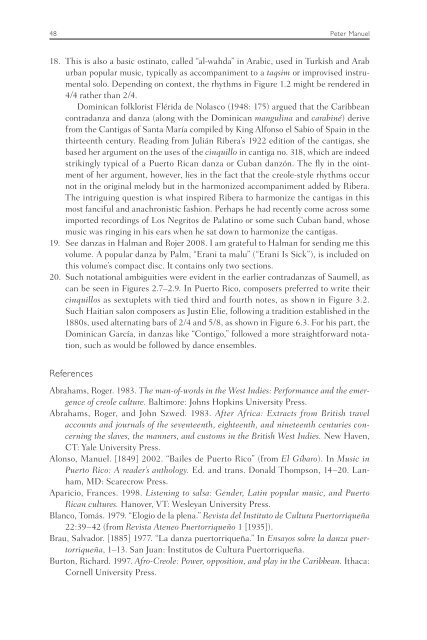Creolizing Contradance in the Caribbean - Temple University
Creolizing Contradance in the Caribbean - Temple University
Creolizing Contradance in the Caribbean - Temple University
Create successful ePaper yourself
Turn your PDF publications into a flip-book with our unique Google optimized e-Paper software.
48 Peter Manuel<br />
18. This is also a basic ost<strong>in</strong>ato, called “al-wahda” <strong>in</strong> Arabic, used <strong>in</strong> Turkish and Arab<br />
urban popular music, typically as accompaniment to a taqsim or improvised <strong>in</strong>strumental<br />
solo. Depend<strong>in</strong>g on context, <strong>the</strong> rhythms <strong>in</strong> Figure 1.2 might be rendered <strong>in</strong><br />
4/4 ra<strong>the</strong>r than 2/4.<br />
Dom<strong>in</strong>ican folklorist Flérida de Nolasco (1948: 175) argued that <strong>the</strong> <strong>Caribbean</strong><br />
contradanza and danza (along with <strong>the</strong> Dom<strong>in</strong>ican mangul<strong>in</strong>a and carab<strong>in</strong>é) derive<br />
from <strong>the</strong> Cantigas of Santa María compiled by K<strong>in</strong>g Alfonso el Sabio of Spa<strong>in</strong> <strong>in</strong> <strong>the</strong><br />
thirteenth century. Read<strong>in</strong>g from Julián Ribera’s 1922 edition of <strong>the</strong> cantigas, she<br />
based her argument on <strong>the</strong> uses of <strong>the</strong> c<strong>in</strong>quillo <strong>in</strong> cantiga no. 318, which are <strong>in</strong>deed<br />
strik<strong>in</strong>gly typical of a Puerto Rican danza or Cuban danzón. The fly <strong>in</strong> <strong>the</strong> o<strong>in</strong>tment<br />
of her argument, however, lies <strong>in</strong> <strong>the</strong> fact that <strong>the</strong> creole-style rhythms occur<br />
not <strong>in</strong> <strong>the</strong> orig<strong>in</strong>al melody but <strong>in</strong> <strong>the</strong> harmonized accompaniment added by Ribera.<br />
The <strong>in</strong>trigu<strong>in</strong>g question is what <strong>in</strong>spired Ribera to harmonize <strong>the</strong> cantigas <strong>in</strong> this<br />
most fanciful and anachronistic fashion. Perhaps he had recently come across some<br />
imported record<strong>in</strong>gs of Los Negritos de Palat<strong>in</strong>o or some such Cuban band, whose<br />
music was r<strong>in</strong>g<strong>in</strong>g <strong>in</strong> his ears when he sat down to harmonize <strong>the</strong> cantigas.<br />
19. See danzas <strong>in</strong> Halman and Rojer 2008. I am grateful to Halman for send<strong>in</strong>g me this<br />
volume. A popular danza by Palm, “Erani ta malu” (“Erani Is Sick”), is <strong>in</strong>cluded on<br />
this volume’s compact disc. It conta<strong>in</strong>s only two sections.<br />
20. Such notational ambiguities were evident <strong>in</strong> <strong>the</strong> earlier contradanzas of Saumell, as<br />
can be seen <strong>in</strong> Figures 2.7–2.9. In Puerto Rico, composers preferred to write <strong>the</strong>ir<br />
c<strong>in</strong>quillos as sextuplets with tied third and fourth notes, as shown <strong>in</strong> Figure 3.2.<br />
Such Haitian salon composers as Just<strong>in</strong> Elie, follow<strong>in</strong>g a tradition established <strong>in</strong> <strong>the</strong><br />
1880s, used alternat<strong>in</strong>g bars of 2/4 and 5/8, as shown <strong>in</strong> Figure 6.3. For his part, <strong>the</strong><br />
Dom<strong>in</strong>ican García, <strong>in</strong> danzas like “Contigo,” followed a more straightforward notation,<br />
such as would be followed by dance ensembles.<br />
References<br />
Abrahams, Roger. 1983. The man-of-words <strong>in</strong> <strong>the</strong> West Indies: Performance and <strong>the</strong> emergence<br />
of creole culture. Baltimore: Johns Hopk<strong>in</strong>s <strong>University</strong> Press.<br />
Abrahams, Roger, and John Szwed. 1983. After Africa: Extracts from British travel<br />
accounts and journals of <strong>the</strong> seventeenth, eighteenth, and n<strong>in</strong>eteenth centuries concern<strong>in</strong>g<br />
<strong>the</strong> slaves, <strong>the</strong> manners, and customs <strong>in</strong> <strong>the</strong> British West Indies. New Haven,<br />
CT: Yale <strong>University</strong> Press.<br />
Alonso, Manuel. [1849] 2002. “Bailes de Puerto Rico” (from El Gíbaro). In Music <strong>in</strong><br />
Puerto Rico: A reader’s anthology. Ed. and trans. Donald Thompson, 14–20. Lanham,<br />
MD: Scarecrow Press.<br />
Aparicio, Frances. 1998. Listen<strong>in</strong>g to salsa: Gender, Lat<strong>in</strong> popular music, and Puerto<br />
Rican cultures. Hanover, VT: Wesleyan <strong>University</strong> Press.<br />
Blanco, Tomás. 1979. “Elogio de la plena.” Revista del Instituto de Cultura Puertorriqueña<br />
22:39–42 (from Revista Ateneo Puertorriqueño 1 [1935]).<br />
Brau, Salvador. [1885] 1977. “La danza puertorriqueña.” In Ensayos sobre la danza puertorriqueña,<br />
1–13. San Juan: Institutos de Cultura Puertorriqueña.<br />
Burton, Richard. 1997. Afro-Creole: Power, opposition, and play <strong>in</strong> <strong>the</strong> <strong>Caribbean</strong>. Ithaca:<br />
Cornell <strong>University</strong> Press.
















